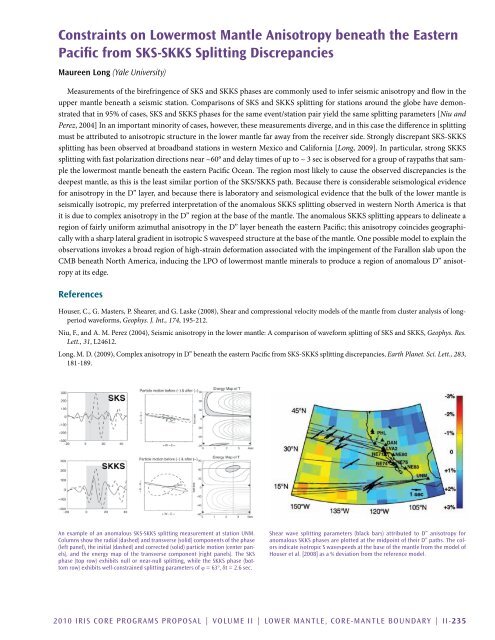Download Volume II Accomplisments (28 Mb pdf). - IRIS
Download Volume II Accomplisments (28 Mb pdf). - IRIS
Download Volume II Accomplisments (28 Mb pdf). - IRIS
Create successful ePaper yourself
Turn your PDF publications into a flip-book with our unique Google optimized e-Paper software.
Constraints on Lowermost Mantle Anisotropy beneath the Eastern<br />
Pacific from SKS-SKKS Splitting Discrepancies<br />
Maureen Long (Yale University)<br />
Measurements of the birefringence of SKS and SKKS phases are commonly used to infer seismic anisotropy and flow in the<br />
upper mantle beneath a seismic station. Comparisons of SKS and SKKS splitting for stations around the globe have demonstrated<br />
that in 95% of cases, SKS and SKKS phases for the same event/station pair yield the same splitting parameters [Niu and<br />
Perez, 2004] In an important minority of cases, however, these measurements diverge, and in this case the difference in splitting<br />
must be attributed to anisotropic structure in the lower mantle far away from the receiver side. Strongly discrepant SKS-SKKS<br />
splitting has been observed at broadband stations in western Mexico and California [Long, 2009]. In particular, strong SKKS<br />
splitting with fast polarization directions near ~60° and delay times of up to ~ 3 sec is observed for a group of raypaths that sample<br />
the lowermost mantle beneath the eastern Pacific Ocean. The region most likely to cause the observed discrepancies is the<br />
deepest mantle, as this is the least similar portion of the SKS/SKKS path. Because there is considerable seismological evidence<br />
for anisotropy in the D” layer, and because there is laboratory and seismological evidence that the bulk of the lower mantle is<br />
seismically isotropic, my preferred interpretation of the anomalous SKKS splitting observed in western North America is that<br />
it is due to complex anisotropy in the D” region at the base of the mantle. The anomalous SKKS splitting appears to delineate a<br />
region of fairly uniform azimuthal anisotropy in the D” layer beneath the eastern Pacific; this anisotropy coincides geographically<br />
with a sharp lateral gradient in isotropic S wavespeed structure at the base of the mantle. One possible model to explain the<br />
observations invokes a broad region of high-strain deformation associated with the impingement of the Farallon slab upon the<br />
CMB beneath North America, inducing the LPO of lowermost mantle minerals to produce a region of anomalous D” anisotropy<br />
at its edge.<br />
References<br />
Houser, C., G. Masters, P. Shearer, and G. Laske (2008), Shear and compressional velocity models of the mantle from cluster analysis of longperiod<br />
waveforms, Geophys. J. Int., 174, 195-212.<br />
Niu, F., and A. M. Perez (2004), Seismic anisotropy in the lower mantle: A comparison of waveform splitting of SKS and SKKS, Geophys. Res.<br />
Lett., 31, L24612.<br />
Long, M. D. (2009), Complex anisotropy in D” beneath the eastern Pacific from SKS-SKKS splitting discrepancies, Earth Planet. Sci. Lett., <strong>28</strong>3,<br />
181-189.<br />
An example of an anomalous SKS-SKKS splitting measurement at station UNM.<br />
Columns show the radial (dashed) and transverse (solid) components of the phase<br />
(left panel), the initial (dashed) and corrected (solid) particle motion (center panels),<br />
and the energy map of the transverse component (right panels). The SKS<br />
phase (top row) exhibits null or near-null splitting, while the SKKS phase (bottom<br />
row) exhibits well-constrained splitting parameters of φ = 63°, δt = 2.6 sec.<br />
Shear wave splitting parameters (black bars) attributed to D” anisotropy for<br />
anomalous SKKS phases are plotted at the midpoint of their D” paths. The colors<br />
indicate isotropic S wavespeeds at the base of the mantle from the model of<br />
Houser et al. [2008] as a % deviation from the reference model.<br />
2010 <strong>IRIS</strong> Core Programs Proposal | <strong>Volume</strong> <strong>II</strong> | Lower Mantle, Core-Mantle Boundary | <strong>II</strong>-235
















